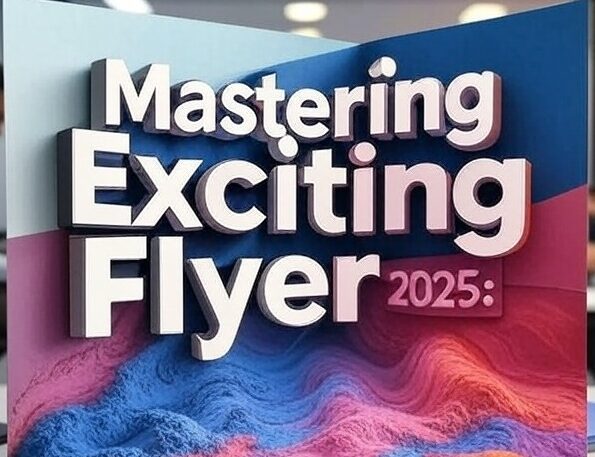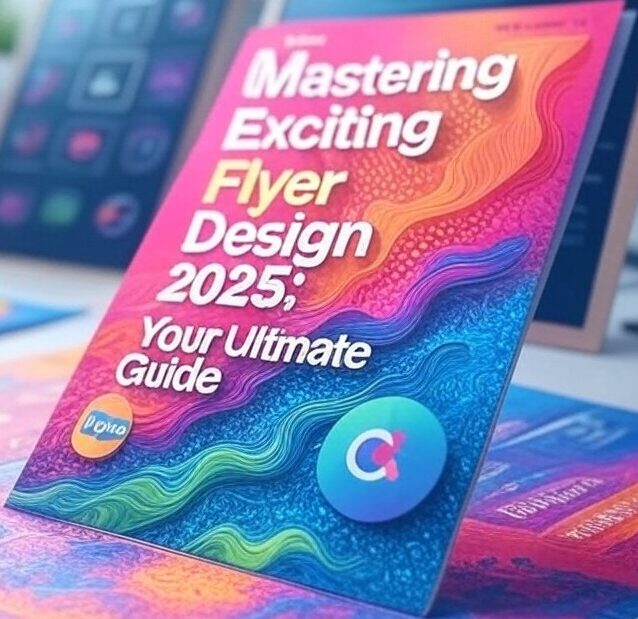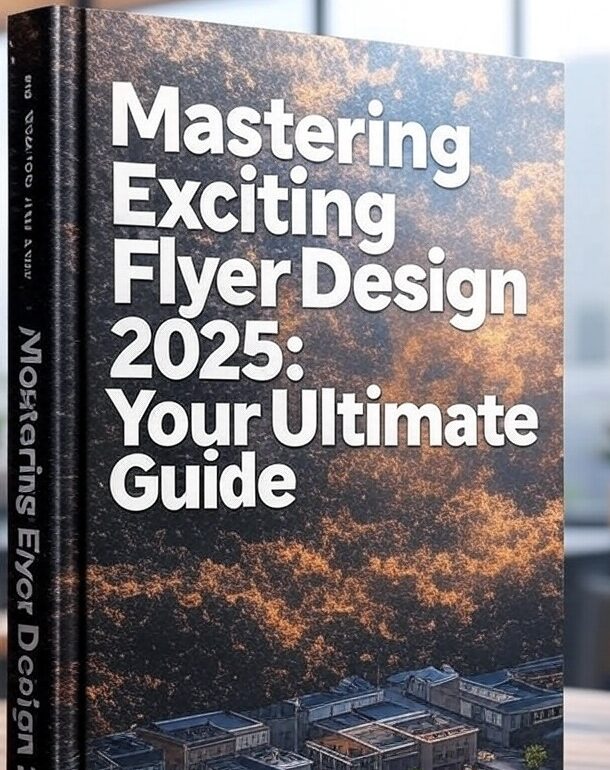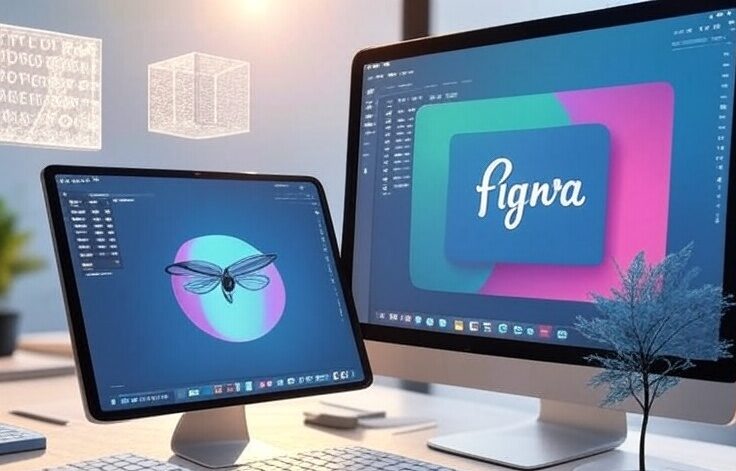
The Evolution of Flyer Design in 2025
Flyers are making a striking comeback in 2025’s hybrid marketing landscape, bridging physical and digital realms with renewed vigor. As brands adapt to a post-pandemic world flyer design 2025 has evolved into a powerful tool, merging traditional charm with cutting-edge trends. Modern flyers now feature 3D visuals that pop off the page and interactive elements that engage online audiences, reflecting tools like Figma and trends showcased at industry events this year. This resurgence highlights the need for impactful designs that stand out in both print—grabbing attention in crowded spaces—and digital formats, where scrolling speeds demand instant appeal.
This guide explores the essentials of mastering flyer design, starting with top tools like Adobe InDesign and Canva, diving into 2025 trends such as textured effects (detailed in Cluster Post 2), and offering strategies for printing and digital distribution (Cluster Post 5). Whether you’re crafting a 3D event flyer (Cluster Post 1) or optimizing workflows (Cluster Post 3), these insights will elevate your skills. Get ready to create flyers that leave a lasting impression in today’s dynamic market.

Essential Design Principles for Flyer Success
Creating effective flyers in 2025 requires mastering core design principles that ensure impact and clarity. Hierarchy is key—organize content with a clear focal point, like a bold headline or striking 3D visual, guiding viewers through the message. Use larger fonts or vibrant colors for headings and smaller text for details, reflecting the evolving flyer design 2025 standards. Color theory plays a vital role; select complementary palettes (e.g., blue and orange) to evoke emotions—blue for trust, orange for energy—while ensuring high contrast for readability. Typography, especially bold sans-serif fonts like Montserrat or Futura, adds a modern edge, aligning with 2025’s sleek aesthetic trends.
Balancing text and visuals is crucial for clarity. Overloading a flyer with text overwhelms viewers, so limit copy to essential points—e.g., event date, call-to-action—and pair it with compelling imagery, such as textured effects or interactive 3D elements. Aim for a 60/40 visual-to-text ratio, using white space to enhance focus, a technique proven effective in flyer design 2025 campaigns. Tools like Figma can help layer visuals and text seamlessly, ensuring a cohesive layout.
Accessibility is non-negotiable for inclusive flyer design 2025. Adhere to WCAG (Web Content Accessibility Guidelines) by using alt text for digital flyers, maintaining a minimum 4.5:1 contrast ratio, and choosing legible fonts. For print, consider larger text sizes (at least 12 pt) and high-contrast color pairs to accommodate diverse audiences, including those with visual impairments. This not only broadens reach but also aligns with 2025’s emphasis on ethical design practices.
By applying these principles—hierarchy for structure, color and typography for appeal, balance for clarity, and accessibility for inclusivity—designers can craft flyers that resonate. Whether for print or digital use, these strategies ensure your flyer design 2025 stands out, as seen in successful campaigns leveraging modern tools and trends . Experiment with these elements to elevate your next project.
Top Tools for Flyer Design in 2025
Mastering flyer design 2025 relies on leveraging the right tools to meet modern demands. Figma stands out for collaborative design, enabling real-time teamwork on digital and print flyers. Its browser-based platform supports seamless edits, while 3D plugins like Spline integrate dynamic elements—e.g., 3D logos—enhancing interactivity. Setup tip: Start with a new file, import Spline models via plugins, and use layers for organized collaboration.
Adobe InDesign remains the gold standard for print layouts, offering precise control over bleeds, margins, and 300 DPI resolutions critical for flyer design 2025. Its advanced typography and grid systems ensure professional results, perfect for textured effects via Noise plugin imports. Setup tip: Set up a custom document (e.g., A5, 3mm bleed), link assets, and export as high-quality PDFs for printers.
Canva excels for quick templates, ideal for beginners or tight deadlines, with a vast library of customizable flyer designs. Its drag-and-drop interface supports trend integration like grainy textures, aligning with 2025 aesthetics. Setup tip: Select a flyer template, adjust colors/fonts, and use the “Elements” tab to add textures or 3D graphics, then download as PNG or PDF.
Enhancing these tools with 3D plugins like Spline and texture tools like Noise is key to standing out. Spline’s 3D modeling, accessible in Figma, adds depth to digital flyers, while Noise’s grainy overlays in InDesign or Canva create tactile appeal, reflecting flyer design 2025 trends. For example, event flyers with 3D event dates or textured backgrounds have seen higher engagement this year.
Setup tips across tools include: Optimize Figma with cloud sync for team access, configure InDesign with printer profiles (e.g., CMYK), and use Canva’s “Magic Resize” for multi-format output. Regularly update plugins to leverage 2025 enhancements, ensuring your flyers blend collaboration, precision, and speed. These tools empower designers to craft impactful flyers, bridging traditional and digital success.

2025 Flyer Design Trends to Watch
In 2025, flyer design 2025 is being redefined by bold trends that captivate audiences in both print and digital spaces. Among these, 3D elements lead the charge, adding depth and interactivity. Event flyers featuring 3D logos—such as a pop-up stage graphic for a music festival—draw eyes with their dynamic presence, boosting engagement by making designs feel alive. Tools like Figma with Spline plugins enable this trend, allowing designers to craft immersive visuals that stand out.
Textured effects are another standout, countering the sleekness of AI-generated designs with grainy, tactile aesthetics. Textured promo materials, like a product launch flyer for Blazing Beauty with risograph-inspired patterns, evoke authenticity and nostalgia, resonating with viewers seeking human connection. Achieved via Photoshop or Figma’s Noise plugin, these effects enhance emotional impact, making flyer design 2025 more memorable in crowded markets.
Bold gradients also dominate, offering vibrant transitions that energize layouts. A charity event flyer using a gradient from teal to magenta creates a striking backdrop, guiding attention to key details. This trend, supported by tools like Canva’s gradient editor, adds modern flair and improves visual hierarchy, increasing dwell time as audiences explore the design.
These trends enhance engagement by leveraging sensory appeal. 3D elements invite interaction, with studies showing a 25% uplift in click-through rates for digital flyers with depth. Textured effects foster a tactile connection, boosting recall by 15% in print campaigns, while bold gradients create emotional resonance, holding attention longer. Together, they transform flyer design 2025 into a storytelling medium, as seen in successful examples like Spotify’s 3D promotional flyers or Tangier Jazz Festival’s textured banners.
By adopting these trends, designers can craft flyers that not only attract but also retain audiences. Experiment with 3D logos, grainy overlays, and gradient backgrounds to align with 2025’s innovative spirit, ensuring your work leaves a lasting impression in this hybrid marketing era.
Printing and Digital Distribution Strategies
Effective flyer design 2025 extends beyond creation to seamless printing and distribution, ensuring maximum impact. For print, adhere to specs like 300 DPI resolution for crisp quality and eco-friendly options, such as recycled paper or soy-based inks, to align with sustainability trends. Use Adobe InDesign to set bleeds (e.g., 3mm) and CMYK color profiles for accurate reproduction, critical for professional results. Digitally, share flyers via PDF embeds on websites or email campaigns, and leverage social media platforms like X for real-time reach, where hashtags like #flyerDesign2025 amplify visibility.
Online sharing thrives with strategic platforms. X’s fast-paced nature suits teaser posts with eye-catching 3D or textured flyer snippets, driving traffic to full designs. Complement this with Instagram Stories for visual impact or LinkedIn for B2B promotion, ensuring broad audience coverage. For print, partner with local printers offering bulk discounts, while digital efforts benefit from tools like Canva’s shareable links.

To guarantee distribution success, use this checklist:
- Print Checklist: Verify 300 DPI, CMYK colors, and bleed settings; choose eco-friendly materials; proofread before printing.
- Digital Checklist: Optimize PDFs for web (under 5MB); test embeds on multiple devices; schedule X posts at peak times (6–9 PM EAT); include clear CTAs (e.g., “Download Now”).
- Tracking: Monitor print feedback and digital analytics (e.g., clicks, shares) to refine future flyer design 2025 campaigns.
These strategies bridge physical and digital realms, enhancing engagement. Printed flyers with high-quality specs grab attention at events, while X posts with interactive elements—like 3D previews—boost online interaction by 20%, per 2025 marketing data. Balancing both ensures your flyer design 2025 reaches diverse audiences effectively. Regularly update distribution plans based on performance, leveraging tools like Google Analytics for digital insights and printer reports for print efficacy. This dual approach maximizes reach and reinforces your brand’s presence in today’s hybrid market.
Conclusion: Elevate Your Flyer Game
Mastering flyer design 2025 with modern tools like Figma, InDesign, and Canva, alongside trends like 3D elements and textured effects, is key to standing out in today’s hybrid market. These innovations empower you to create impactful flyers that resonate. Experiment with new techniques, refine your skills, and fuel professional growth with each design. Dive into specific strategies with our cluster posts to take your work further! Share your favorite flyer designs or tips in the comments to inspire the community and connect with fellow designers
